The Catla carp (Catla catla Hamilton: 1822) is an Indian Major Carp and one of the major aquaculture species of India, Bangladesh, Myanmar (Burma) and Pakistan (Jhingran, 1986). In India, Catla catla is found in almost all the major and minor rivers, lakes, beels and it is being cultured in all the states of India due to its high growth rate and high market price.
The natural breeding of Catla catla has become uncertain due to continuous degradation of habitat caused by environmental modification and manmade interventions, leading to decreased Catla populations in the state of Orissa.
Inbreeding is a common scenario in all the hatcheries of Orissa with mass stocking of genetically inferior fry in hatcheries having the potential to cause feral gene introgression in to hatchery raised seeds. Little genetic information is available on Catla catla species in Puri and Ganjam Districts of Orissa state. Therefore, this study was carried out to evaluate the genetic variation and phylogenetic relationship among the two different stocks of Catla catla in Orissa based on RAPD profiles.
In the present investigation, the genetic diversity of two stocks of Catla catla was studied through RAPD analysis and the phylogenetic cluster was done using UPGMA with NTSYS pc version 2.2 software. The result indicated that the two stocks of Catla fall under one phylogenetic cluster. The mean intra-species GS values were 0.7897± 0.663 for Puri stock and 0.836± 0.599 in case of Ganjam stock respectively. The highest GS values, within the stock were obtained for Ganjam followed by Puri. These intra-species GS values estimated for 2 stock were checked by one way ANOVA (SPSS version 16) and found to be significantly different at P
Introduction
The Aquaculture systems in India and its neighbour such as Bangladesh and Pakistan, mainly constitutes IMC’s viz. the Catla (Catla catla; Hamilton) the Rohu (Labeo rohita; Hamilton), Mrigal (Cirrhinus mrigal; Hamilton). These carps contribute approximately 75% to the Aquaculture production in India (FAO, 1997). As these carps are economically very important research on cultivating these species of fish was initiated in India during early 1950’s to study and understand the biology of these economically important species, particularly, the major carps and to develop suitable technologies for various farming systems.
However, as a single species, Catla catla contributed 1,235,992 mt. to the total World Aquaculture production in 2005 (FAO, 2007). To identify molecular genetic markers, various techniques are used to detect polymorphisms in the population. A polymerase chain reaction based DNA typing requires no prior knowledge of target DNA sequence, termed RAPD-PCR (for random amplified polymorphic DNA) is found to generate genetic diversity assessment in fishes. The knowledge of genetic background of a species and its population structure is essential for success in breeding, management and conservation programs in fisheries.
Individuals with high level of genetic variation have great prospect in aquaculture in terms of higher growth rate, development, stress and diseases resistance (Carvalho, 1993). Therefore, detection of genetic variation at species and population level is of crucial importance for sustainable aquaculture practices. Genetic variation at species level helps to identify the taxonomic units and to determine the species distinctiveness that can provide essential information for conservation, systematic, ecological and evolutionary studies (Schieverwater et al., 1997).
Variation at the population level can provide an idea about how many different genetic classes are present and the genetic similarity among them, how much diversity is present in those classes and their evolutionary relationship with wild relatives. The genetic variability within population is extremely useful to gather the information on individual identity, breeding pattern, degree of relatedness and distribution of genetic variation among them.
Such studies are highly informative for the management of small group in ex-situ collection, cultivars identity, breed or clonal identification and for paternity testing. Williams et al., (1991) developed a PCR-based genetic assay named as Random Amplified Polymorphic DNA (RAPD) method, which detects nucleotide sequence polymorphism in genomic DNA regions by using short oligonucleotide primers of arbitrary sequence, typically a length of 10 nucleotide. RAPD assay reports numerous loci that allow the examination of genetic variation and phylogenetic relationship without prior knowledge of DNA sequence.
Since it is PCR based, RAPD is relatively easy, fast and efficient method which requires only a small amount of DNA for the study. This technique has been useful for detection of genetic variation in various fish species. It has been used for phylogenetic studies for species and subspecies identification in fish. Random Amplified Polymorphic DNA-PCR (RAPD-PCR) technique was used by Williams et al., 1990; Welsh & McClelland, 1990 for fish species identification. The present investigation involves the evaluation of the genetic diversity and the molecular phylogeny within and between the two stocks of Catla catla from Orissa based on RAPD technique which in turn will be useful to provide valuable information for breeding, conservation, systematic, and ecological and evolutionary studies in Catla catla.
Material and Methods
Catla yearlings were collected from four different places in Orissa. A total of 30 samples from each place was collected. The 1st sample was collected from a private Hatchery at Puri near Brahmagiri, the 2nd sample was collected from Government Hatchery of State Department of Fisheries, Kausalyaganga, 3rd sample was collected from Ganjam District at Puroshattampur (Buguda) and 4th sample from the same District at Chatrapur. Each sample was collected inside the District at a distance of about 60-70 Kms from each other. A small piece of fin tissue was cut from the Pelvic, caudal and dorsal part of the live fishes using clean Scissor and forceps. Hands of the collector are cleaned of mucous and scales between handling fish. The scissors, knife or forceps are rinsed with water and every time the fins were cut the knife, scissors or forceps are disinfected with Potash/Sodium chloride/95% alcohol. The process followed here is the wet fin clipping. The fins were cut and placed in a small plastic vial containing high strength of (95%) ethanol preserves the tissues in room temperature.
Fig.1. Map of Orissa Showing Sampling Sites in the two different Districts of Orissa Puri & Ganjam
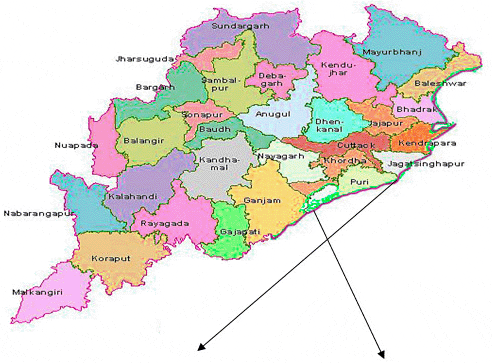

DNA was isolated from the fish tissue using a standard SDS-Phenol / Chloroform method with minor modifications (Singh, 2000).About 100 -150 mg of tissue was taken in 500ml cell lysis buffer in a sterile Eppendorf tube. 3-4 ml of Proteinase-K (20mg /ml) was added to it and mixed thoroughly.
The solution was incubated at 54oC for 5hrs (or 37oC overnight) till the completion of cell lysis.An equal amount (i.e, 500 ml) of Tris-saturated phenol and Chloroform and Isoamyl alcohol (P: C: I) mixture (25:24:1) was added and mixed gently by inverting the tube. The above mixture was centrifuged at 10000 rpm for 10 minutes and the upper aqueous phase was collected in a fresh Eppendorf tube without disturbing the interphase.
The phenolization was repeated till the top layer was transparent and clear.The clear aqueous phase was pipetted out and 1/10th volume of 3M Sodium Acetate (pH 5.2) solution was added to it followed by gentle mixing.
The DNA was precipitated out with 2/3rd volumes of 2-propanol (or 2 volumes of chilled absolute alcohol.The DNA pellet obtained after spinning at 5000 rpm for 5 mins at 4oC was washed two to three times with 70% alcohol and finally once with absolute alcolol. Then it was air dried.
Finally DNA pellet was dissolved in 100ml of TE (10mM Tris & 1mM EDTA) buffer and stored at 4oC for further use. RNase treatment was optional and steps 8-10 were repeated. Then the quantification of the obtained DNA was done by Thermo UV-VIS 1 spectrophotometer. Optical densities of the DNA samples were measured at 260 nm and 280 nm to determine the quantity and purity of isolated genomic DNA and then OD260/OD280 ratios were also calculated. Then the RAPD Analysis was carried out by Random Primers named OPC-02, OPC-16, OPC-18, and OPC-11 by PCR amplification.
Then the RAPD- PCR products were detected by using agarose gel electrophoresis where the staining of gels was done by ethidium bromide. Then the molecular weight determination was done by lab work software and the statistical analysis of the data was carried out. The RAPD fingerprinting generated for all samples were compared within and between different populations. Data scored manually based on the presence or absence of band of identical molecular size. The presence of bands were scored and added to get number of bands with a particular primer.
Comparisons were carried out between samples amplified by the same primer in a pair wise manner. The similarity index between individuals was calculated following the method of Nei and Li (1979). Genetic similarity between individuals A and B (SAB) was calculated using the formula:
SAB = 2NAB / (NA + NB)
Where,
SAB = rate of band sharing
NA= number of bands in individual A
NB = number of bands in individual B
NAB = total number of bands shared by both A and B individual
Further, the statistical analysis was carried out by using one-way analysis of variance (ANOVA) in SPSS version 16 program to estimate genetic variation. Cluster Analysis was then done using UPGMA to create dendogram with Numerical Taxonomy and the Multivariate Analysis System (NTSYS-pc, version 2.2) program.
Results
PCR reaction was standardized to generate polymorphic pattern. DNA samples of one catla species from two different districts of Orissa were selected randomly from the total of twenty samples for primer screening and selection. A total of 04 decamer primers namely OPC-02, OPC-16, OPA-18 and OPA-11 from Operon Technologies Inc. series were tested for PCR amplification in one species of catla.
All primers have shown bands amplification in one species of catla catla collected from two different districts of Orissa but out of these four primers, all primers generated very strong amplification with 75-80%% reproducible polymorphic DNA bands in above tested two stocks. Therefore, four primers namely OPC-02, OPC-16, OPA-18 and OPA-11 were finally selected for polymorphic DNA analysis in the present investigation.
Then RAPD products was detected using Electrophoresis on agarose gels and ethidium bromide (EtBr) staining was usually found sufficient for detection of RAPD-PCR products. The RAPD banding profiles (size in bp) were analyzed in PC using “Kodak 1D Image Analysis Software” for the determination of molecular size of amplified bands by comparing with known standard molecular weight marker (100 bp DNA ladder) in the gel. However, the molecular size of DNA bands given in the table after software analysis may vary minimum in a range of 5-10 bp for each molecular size of DNA bands.
Fig.3. RAPD Profile of ten individuals of Catla catla collected from Puri using primer OPC-02
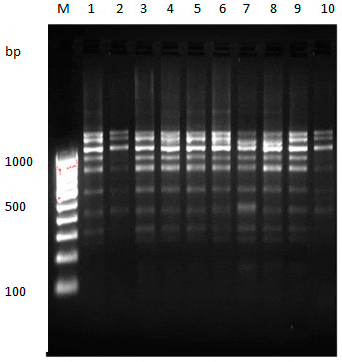
Lane 1-10--- PCR amplified product of ten individuals of Catla catla
Fig.4. RAPD Profile of ten individuals of Catla catla collected from Puri using primer OPC-16
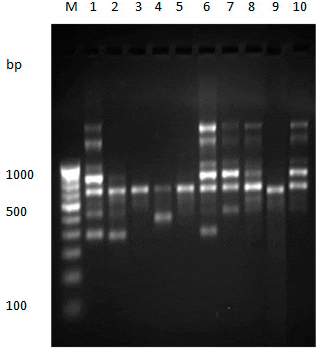
Lane 1-10--- PCR amplified product of ten individuals of Catla catla
Fig.5. RAPD Profile of ten individuals of Catla catla collected from Puri using primer OPA-18
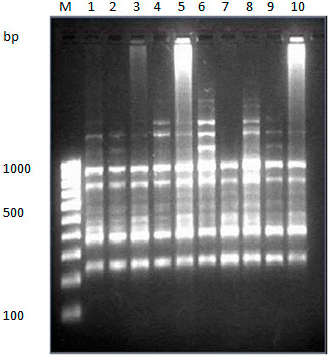
Lane 1-10--- PCR amplified product of ten individuals of Catla catla
Fig.6. RAPD Profile of ten individuals of Catla catla collected from Puri Using Primer OPA-11
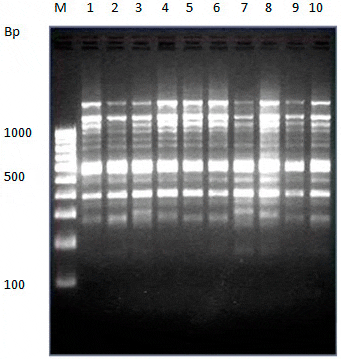
Lane 1-10- PCR amplified product of ten individuals of Catla catla
Fig. 7. Dendogram of 10 individuals of Catla catla collected from Puri District

Fig.8. RAPD Profile of ten individuals of Catla catla collected from Ganjam using primer OPC-02
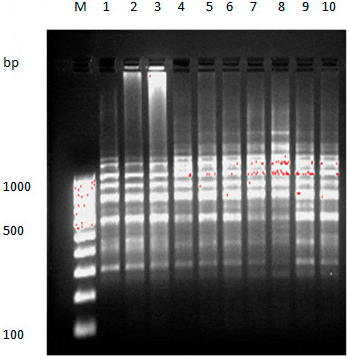
Lane 1-10--- PCR amplified product of ten individuals of Catla catla
Fig.9. RAPD Profile of ten individuals of Catla catla collected from Ganjam using primer OPC-16
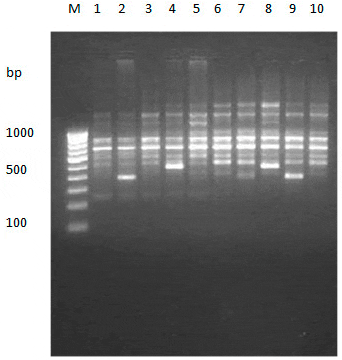
Lane 1-10--- PCR amplified product of ten individuals of Catla catla
Fig.10. RAPD Profile of ten individuals of Catla catla collected from Ganjam using primer OPA-18 .
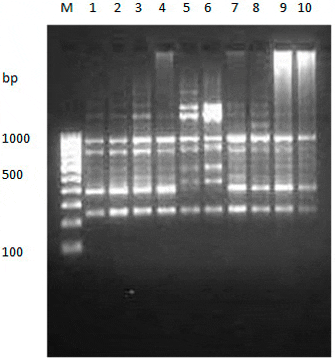
Lane 1-10--- PCR amplified product of ten individuals of Catla catla
Fig.11. RAPD Profile of ten individuals of Catla catla collected from Ganjam Using Primer OPA-11
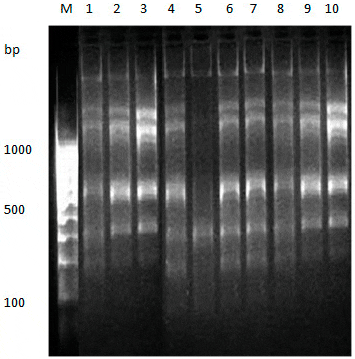
Lane 1-10- PCR amplified product of ten individuals of Catla catla
Fig.12. Dendogram of 10 individuals of Catla catla collected from Ganjam District
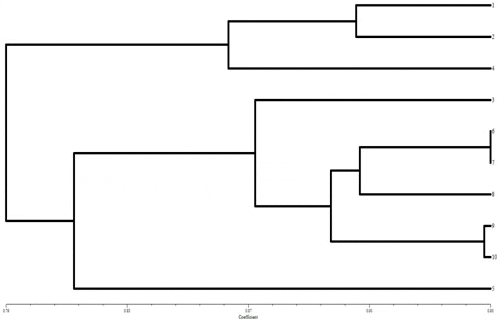
Fig.13. Comparative RAPD Profile of two different stocks of Catla catla using Primer OPC-02
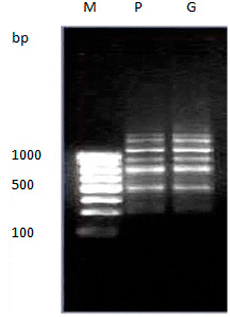
Lane P & G- PCR amplified product of two stocks of Catla catla
Fig.14. Comparative RAPD Profile of two different stocks of Catla catla using Primer OPC-16
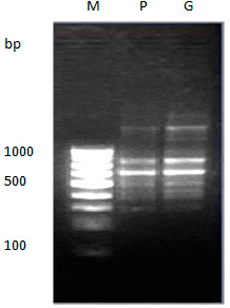
Lane P & G- PCR amplified product of two stocks of Catla catla
Fig.15. Comparative RAPD Profile of two different stocks of Catla catla using Primer OPA-18
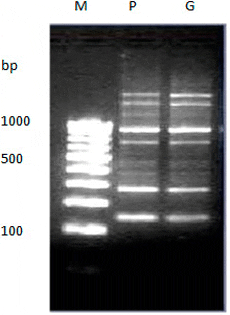
Lane P & G- PCR amplified product of two stocks of Catla catla
Fig.16. Comparative RAPD Profile of two different stocks of Catla catla using Primer OPA-11
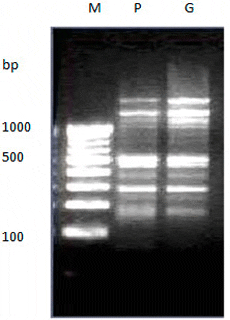
Lane P & G- PCR amplified product of two stocks of Catla catla
Fig.17. Dendogram of two stocks of of Catla catla collected from Ganjam and Puri District

Then the genetic similarity (GS) matrices for intra-species variation were calculated with DICE coefficient with NTSYS software by pair-wise comparison of ten individuals in each stock following the method of Nei & Li (1979). The GS values for each stock ranged from 0.67± 0.663in Puri and 0.70± 0.599 in case of Ganjam stock (Table-18). The mean intra-species GS values were 0.7897± 0.663 for Puri stock and 0.836± 0.599 in case of Ganjam stock respectively (Table-18). The highest GS values, within the stock were obtained for Ganjam followed by Puri. These intra-species GS values estimated for 2 stock were checked by one way ANOVA (SPSS version 16) and found to be significantly different at P<0.001(Table-20).
Similarly the two representative DNA samples from each of the two stocks of Catla were selected primer-wise for inter-species genetic variability analysis (Fig-13, 14, 15 & 16). The matching coefficients of genetic similarity for same four primers that amplified 78 bands were calculated using the NTSYS pc 2.2 software with DICE coefficient. The inter-species GS values obtained through the program were estimated to be (all values per 1.000) for Puri/Ganjam is 0.943 (Table-15). From the analyzed data it indicates that, both the stocks are more genetically similar with highest GS value of 0.943.
Table 5. Genetic similarity values between ten individuals of Catla catla of Puri District
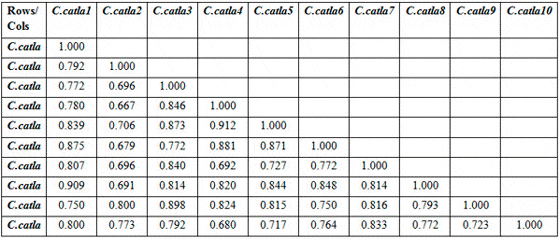
Table 10. Genetic similarity values between ten individuals of Catla catla of Ganjam District
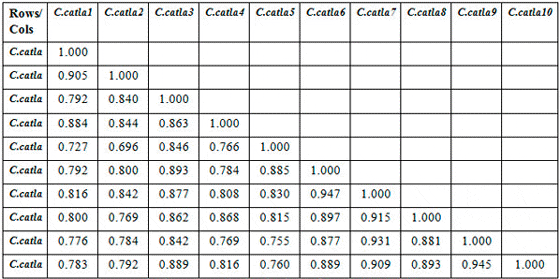
Table 15. Similarity matrix between the two stocks of Catla catla based on polymorphic DNA bands.
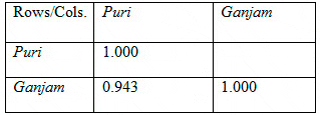
Table 18. Summary of the mean genetic similarity (GS) values, standard deviation, standard errors, minimum and maximum values obtained within each of the one species of Catla using SPSS (version 16) program

Table 20. Summary of the results of one-way ANOVA to test for difference in intra-species genetic similarity (GS) values among the individuals of each species of Catla calculated based on RAPD banding patterns
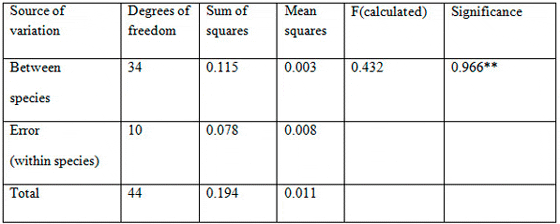
Discussions
The banding patterns generated through RAPD assay in the present study were used to deduce variation within and between the two stocks of Catla catla of Orissa. The degree of similarity of banding profiles is the best criteria to estimate the genetic variation and nucleotide diversity (Clark and Lanigan, 1993). The presence or absence of DNA bands of identical molecular weight was the index to calculate the genetic similarity values.
The mean intra- species GS values estimated in the present study differing from one another were ranging from 0.7897 ± 0.6638 in Puri stock and it was maximum in Ganjam to that of Puri i.e. 0.8368 ± 0.59985 (Table-18). This indicates an overall low genetic variation within the species. A possible explanation to the above result may be that each stock was studied from only a single population.
More over samples were drawn randomly from confine geographical locations. A comparatively higher GS vales in case if Ganjam stock to that of Puri in the present study may be because of regular breeding activities resulting in inbred progenies in restricted population. In most of the fish population studies, it has been observed that, inbreeding depression of desirable traits in species involving frequent reproduction failures reducing overall viability, poor growth and survival and increase of physical abnormalities in various strains.
As regards the inter-species genetic variation among the two stocks of Catla catla collected from Ganjam and Puri, genetic similar between the two stocks is 0.943. Dinesh et al. (1996) supported the validity of RAPD analysis in Tilapia by estimating inter-species genetic variation and phylogenetic studies. These inter-species genetic similarity estimates were further used to hypothesize the phylogenetic relationship among them. Bradacki & Skibinski (1994) in three species of tilapia viz O. mosambicus, O. niloticus, and O. aureus did a similar study using RAPD markers.
They linked O. mosambicus with the O. niloticus where as O. aureus as out group. Oon Kim Leong et al. (2001) has classified the genus Labeo barbus on the basis of RAPD-PCR and developed dendogram showing the genetic relationship between individuals of L. oscellatus, L. festicus, L. leptochelius (taken from different location).
Conclusion
In conclusion this indicates that the RAPD technique provided a reliable and useful tool for identification and estimation of genetic variability both within and between the two stocks of Catla. Furthermore the RAPD technique is simple, fast and less expensive than other techniques of PCR, such as microsatellite or RFLP analysis (Caetano-Anolles, 1994; Jones et al., 1997; Harry et al., 1998). It is noteworthy to mention the fact that data results from RAPD assay can be extended to further dissect traits in a more refined way to get information on specific genes and genetic pathway using other molecular methodologies. There is also the opportunity and need to study sequence of specific polymorphic bands as in SCAR analysis (Paran & Michelmore, 1993) to determine the genes detected by RAPD experiments. The possible use of DNA markers in future by genetic engineering may create many vistas for fish molecular biological research.
July 2013



